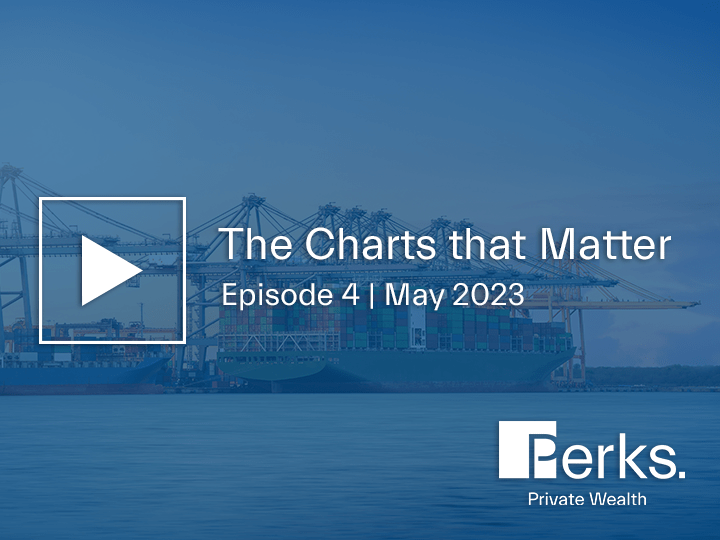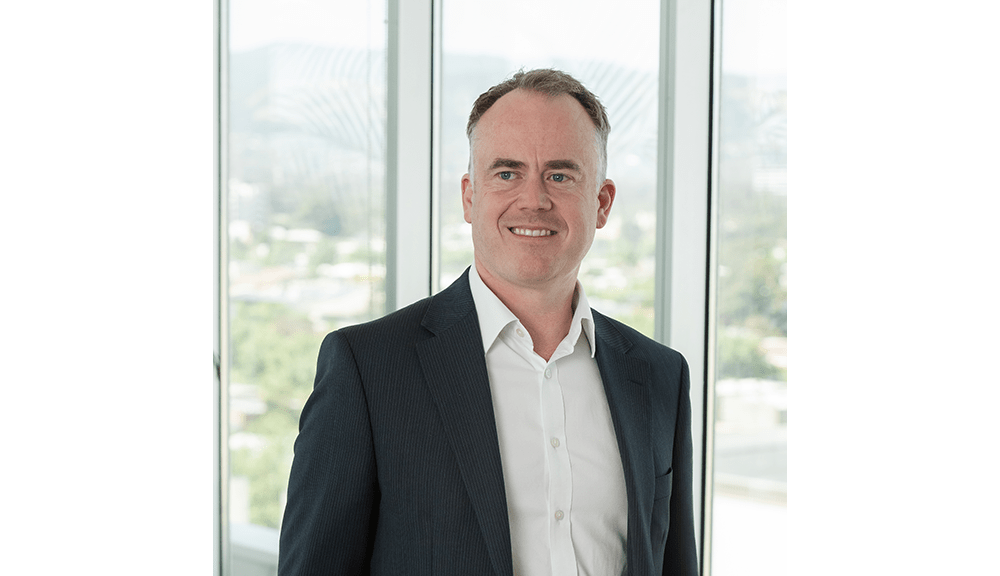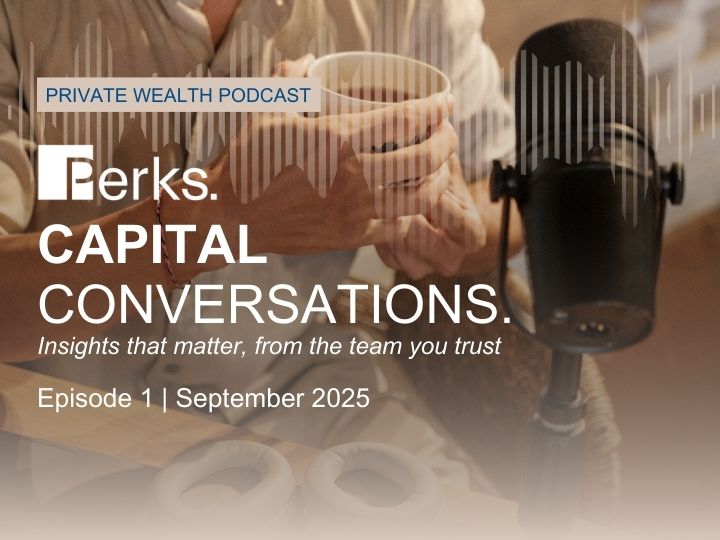Transcript:
Simon Hele:
Hi everyone. My name is Simon Hele, Director of Perks Private Wealth. And I’m pleased to welcome you to another edition of the Charts that Matter. As always, I’m joined by the chair of our investment committee, Christo Hall.
Today, I’m going to discuss with him our investment committee thoughts and views on markets. What’s happening? Where are we now? And where we see things as we look ahead.
Welcome, Christo.
Christo Hall:
Thanks Simon. Interest rates have been a key thematic in our conversations and indeed in markets over the last twelve to eighteen months. In our last installment of the Charts that Matter, the RBA cash rate was sitting at 3.35 percent.
And we’d forecast two or three more rate rises to push the cash rate through four percent in Australia and five percent in the US. Christo, can you provide an update on interest rates? Yeah. Sure, Simon.
So that’s exactly what’s happened since our last meeting, we’ve had further rate rises both in Australia and the US.
So the cash rate in Australia is now sitting at 3.85 percent and we’re expecting another rate rise to come pretty soon.
And assuming the US we’re expecting another one or two rate rises to happen over the next few months. So we still haven’t got inflation under control yet, and this is gonna be something the markets have to deal with. When you look at what the markets are pricing in for the trajectory of rates, it’s very interesting.
Particularly in the US.
The US is pricing in rate cuts to begin this year.
Round about September or October.
I’m not at that view. I think that inflation is gonna be faster here than that in the US and therefore, we won’t see any rate cuts either in Australia or the US until well into 2024.
Despite the fact that the market’s a pricing in that scenario in the US and to a lesser degree in Australia. It’s not as aggressive that rate cut projection in Australia, but we’re not of that view.
Simon Hele:
So, Christo, inflations come off peak. But markets are quite optimistic.
What’s your response to that?
Christo Hall:
I think the market’s being overly optimistic about how far inflation’s going to fall. So it definitely has come off its peak levels, and the forecasts are for inflation to head back towards 5 percent next year and then down to 3.5 percent or even lower than that.
The year after. I think the challenge though is in as you’ll see in the chart in front of you now, is that if you look at the components of inflation, it’s really important to understand this. You’ve got the good side which you’ll see in the blue line which has come off its peak.
That’s certainly showing signs of improvement, and that’s because supply chains have opened up.
And inventory is flying a lot more freely around the world. So those cost pressures are abating there. But the orange line is the services component and that’s still going up. And that’s a really important part of it because that is representing rents and wages.
And you would have all seen in the press what’s happening in the property market, what sort of rental increases are happening there.
Even two days ago, Telstra, for example, has announced a has announced a 7 percent increase in their pricing for their phone services.
And they’re citing the reason for that is to deal with their their rising cost structures, you know, such as wages in their business. So All these businesses are passing on these costs, particularly in wages through the consumers. So our view is that as this settles down, as we look out for the next two or three years.
And this is very important. Inflation is going to settle between 2.5 percent and 3.5 percent longer term. It’s not going back to the levels of 2 percent to 2.5 percent or even lower that we’ve had before that. And that has a very important outcome for where cash trades are gonna settle.
Simon Hele:
In our last discussion, we talked about the early signs of stabilisation in GDP growth forecasts.
Though we also pointed out the inverted yield curve as a precursor to US recession.
How have things evolved in the last few months?
Christo Hall:
Yeah, that’s an interesting one, Simon. So there are two charts you can see on the screen now. So firstly economic growth for the US and Australia.
Is still showing signs of stabilisation, which I think surprised some people that the the expectation was that that may have fall a little bit further. But certainly, I think it’s just showing that there is some resilience there in the economy at this point.
What we need to wait and see is where the rate increases have really started to hit the consumer yet.
My suspicion is it hasn’t fully done that yet. And so I don’t think we’re gonna see a hockey stick turnaround in economic growth here. You’ll get a flat line from where it is now. So end up with a sub trend growth level of probably just under three percent for both, which is okay, but it’s not stellar.
The second chart you’ll see is just where the leading indicators are showing that the inverted yield curve is pointing to more troubled times ahead. It’s very indicative of a recession when you have a negative yield curve, particularly as sharp as the one that’s shown on the chart.
So we have to wait and see how this pans out. It’s not following a traditional recessionary slowdown, the data yet. And that could be for a number of reasons. It could be because I think the savings rate got to such a high level during COVID.
And even though it’s come down a lot in that last eighteen months or fifteen months, The consumer’s still weathering this pretty well, but I still think that with those rising interest rates and high cost of living, all those inflationary pressures that it’s gonna lead to a much more subdued economic outlook over the next few years. So what I’m hearing Christo is we remain cautious in our outlook, yet the equity markets are a bit more optimistic than we’ve been. What’s your comment on that? Yeah, they certainly have in the last couple of months.
I think we’ve seen certainly earnings downgrade flow through the market and that was our expectation.
But the markets tending to look through some of these a bit more than what we thought that they would do.
Particularly in the large tech stocks.
You’ve seen some very big moves in share prices there in recent weeks.
And a lot of that is to do with their ability to cost cut, and we’ve certainly seen that with companies like Tesla.
Which have reduced their cost base, their labor cost base by around about 70 percent so it’s very meaningful.
But it’s also worth pointing out that the rally that we’ve seen the market it’s been very narrow.
It’s been really a handful of stocks, particularly in the US, probably 5 or 6 stocks. Which have driven the bulk of the rally, whereas really if you look at the broader market, only about a third of the stocks in the S & P 500 to participate in the rally. So need to be very conscious of that.
And we just wanna see how this earning slowdown pans out, but my feeling is that we’ll still get downgrades, but the magnitude of those downgrades is starting to slow.
Which would tie-in with the fact that the economic growth is starting to just even though it’s been cut quite a lot, it’s starting to to base out here, so that would tie in with that narrative pretty effectively.
And then looking at the valuations, the markets just aren’t cheap anymore. They’re not super expensive, but they’ve reached their fair value from where we sit now. So not seeing too much upside from here.
Simon Hele:
Well, thanks, Christo. That’s been incredibly insightful. If you were to sum it up, what’s an investor to do?
Christo Hall: So I think you’d still be patient here Simon. So if you look at the asset classes across the board, the beauty is we’re getting paid to hold money in cash now. You can get 4.5 on a term deposit, which is a good return.
Particularly versus what we’ve seen in the last in the last decade or so for fixed interest or for cash.
The share market’s looking, as I mentioned in my previous comments, is looking is looking fully valued.
It doesn’t look super expensive, but I think that the market’s just gonna be stuck in a broader trading range for a while now until we get some clarity on that. But I don’t think you’re going to see any kind of really significant drawdowns there.
I certainly prefer fixed interest to equities, to shares. At the moment, I think there’s still some real value in the fixed interest market.
Particularly as the economies begin to slow even though that rate of that rate of softness is declining. I still think it’s gonna be challenging for economies to start getting back into, you know, back into first gear really quickly. It’s just gonna be a bit of a long slow process as we muddle our way through here.
Simon Hele:
So the view we’ve taken to stage money in over time, is that still appropriate?
Christo Hall:
That’s still appropriate. Absolutely. So when you had these periods of weakness, particularly in the share market, you ease into it. I think that’s really important.
For those that have been sitting in cash, you haven’t missed out because the markets haven’t run away for the last six months overall. They’ve just been in a range trading scenario.
It’s gonna be a lot more volatile than what we’ve been used to. That’s a really important thing to highlight.
So you ease into this, you deploy money when you see opportunities, of which there will be many.
But I don’t see a rapid change in the direction of markets in the next 6 months.
Simon Hele:
Thanks, Christo, and thanks for everyone for joining us for the Charts that Matter.








